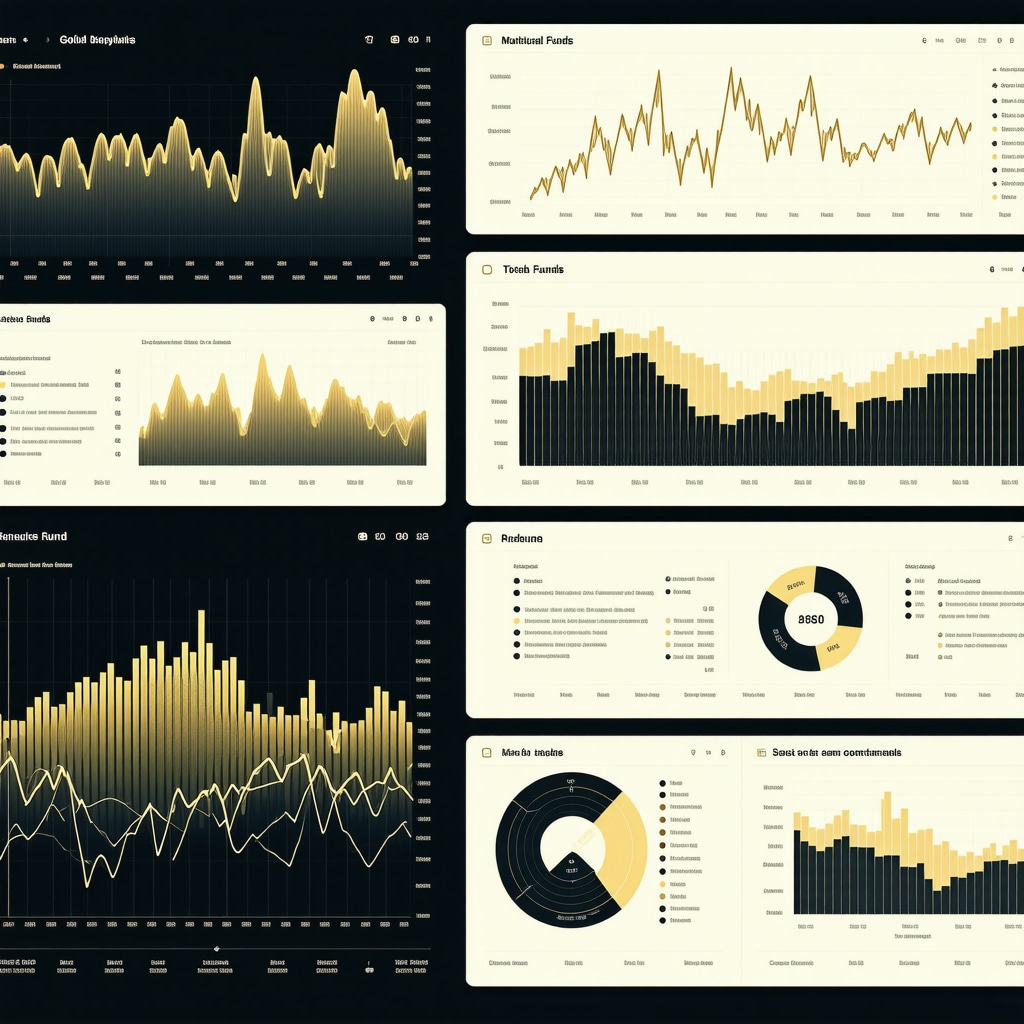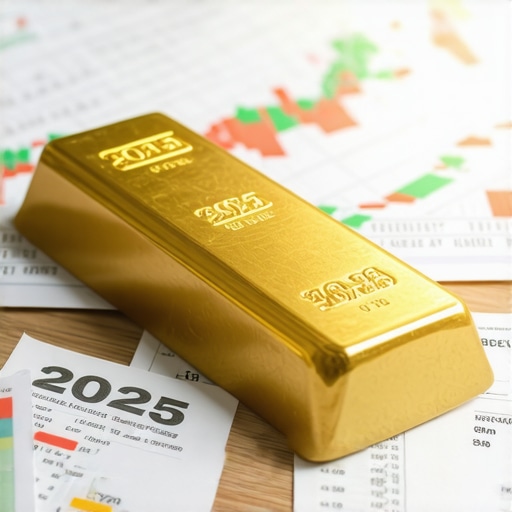Strategic Foundations of Gold Mutual Funds in Portfolio Diversification
Gold mutual funds offer a sophisticated vehicle for investors seeking to harness the intrinsic value of gold while benefiting from professional management and liquidity. Unlike direct gold purchases, these funds pool capital to invest in a diversified basket of gold-related assets, including bullion, mining equities, and derivatives. This structure provides nuanced exposure to gold’s price dynamics, income potential, and growth prospects, making it an essential component for hedging against inflation and market volatility.
Decoding the Complexities of Income Generation through Gold Mutual Funds
Income from gold mutual funds typically arises via dividends from gold mining companies and interest from debt instruments linked to the gold sector. However, the yield profile varies significantly across funds depending on asset allocation, geographic focus, and management strategy. Funds emphasizing established mining firms often prioritize steady dividend income, while those with a growth tilt reinvest earnings to capitalize on capital appreciation. This dual approach necessitates a robust understanding of sector-specific risk factors, including geopolitical influences and commodity price fluctuations.
Advanced Selection Criteria: Balancing Risk and Return in Gold Mutual Funds
Expert investors apply multi-dimensional evaluation frameworks when selecting gold mutual funds. Critical factors encompass expense ratios, historical risk-adjusted returns, fund manager track record, and alignment with macroeconomic trends such as inflation trajectories and currency fluctuations. Additionally, scrutinizing the fund’s exposure to physical gold versus mining stocks informs the balance between capital preservation and aggressive growth. For instance, funds with higher physical gold holdings tend to exhibit lower volatility, aligning with conservative income strategies.
How Do Macroeconomic Variables Influence Gold Mutual Fund Performance?
Gold mutual funds are inherently sensitive to macroeconomic variables such as interest rates, inflation expectations, and currency strength. Rising inflation typically enhances gold’s appeal as a real asset, boosting fund performance. Conversely, higher interest rates may depress gold prices by increasing opportunity costs, thereby impacting funds disproportionately weighted in bullion. Currency depreciation, especially of the US dollar, often correlates with gold price rallies, benefiting funds with international exposure. Understanding these dynamics allows investors to anticipate fund performance in evolving economic conditions.
Integrating Gold Mutual Funds Within a Long-Term Growth Framework
Incorporating gold mutual funds into a long-term growth strategy requires a tailored approach balancing income stability and capital appreciation. Advanced portfolio construction involves blending funds with complementary risk profiles and geographic diversification to mitigate sector-specific shocks. Investors are advised to monitor evolving trends detailed in resources like the Ultimate Guide to Gold Mutual Funds for Long-Term Investors 2026, which offers in-depth analysis on fund selection calibrated to future market scenarios.
For comprehensive insights into gold price drivers that underpin mutual fund valuations, explore Gold Supply and Demand: What Moves Gold Prices in 2026.
Enhance your investment acumen by sharing your experiences or questions on advanced gold mutual fund strategies in expert forums and contribute to the evolving discourse on precious metal investment.
According to a detailed analysis by the World Gold Council, the interplay between monetary policy and gold demand remains pivotal in shaping investment outcomes in gold funds (World Gold Council Research).
Leveraging Quantitative Models for Predictive Gold Mutual Fund Analysis
In the realm of gold mutual funds, quantitative modeling offers a powerful methodology to anticipate fund performance amidst fluctuating market conditions. By incorporating variables such as gold price volatility, mining sector earnings, and macroeconomic indicators, investors can construct predictive analytics frameworks. These models often utilize machine learning techniques and time-series analysis to capture non-linear relationships and cyclical trends, providing a more nuanced forecast than traditional fundamental analysis alone. Emphasizing data-driven decision-making enhances the precision of portfolio adjustments and risk management.
What Role Does Behavioral Finance Play in Gold Mutual Fund Investment Decisions?
Beyond the quantitative and fundamental factors, behavioral finance introduces critical insights into how investor psychology influences gold mutual fund flows and price movements. Cognitive biases, such as loss aversion and herding behavior, can exacerbate price volatility and create market inefficiencies. For instance, during periods of economic uncertainty, investor sentiment often disproportionately favors gold as a safe haven, sometimes leading to overvaluation. Understanding these psychological dynamics equips sophisticated investors to time their entry and exit points more effectively, mitigating emotional decision-making risks.
To deepen your understanding of these behavioral patterns and their impact on gold asset classes, consult studies by the CFA Institute which extensively explore investor psychology in commodity markets (CFA Institute Research on Behavioral Biases).
Integrating Gold Mutual Funds with Alternative Asset Classes for Enhanced Portfolio Resilience
Expert portfolio managers often advocate for a strategic blend of gold mutual funds alongside other alternative assets such as real estate investment trusts (REITs), infrastructure funds, and private equity. This diversification strategy aims to reduce overall portfolio correlation to traditional equity and fixed income markets, thereby smoothing returns in turbulent economic cycles. Gold mutual funds, with their unique risk-return profile, complement these asset classes by providing liquidity and inflation protection, especially during stagflationary environments.
Advanced asset allocation strategies recommend periodic rebalancing, leveraging insights from resources like Top Gold Mutual Funds for Steady Income in 2026, which detail funds optimized for income and growth in diversified portfolios.
Assessing the Impact of Emerging Technologies on Gold Mining Stocks Within Mutual Funds
Technological innovation is reshaping the gold mining landscape, influencing the valuation of mining stocks held within mutual funds. Breakthroughs in automation, AI-driven exploration, and sustainable mining practices can significantly improve operational efficiency and cost structures. Funds with substantial exposure to technologically advanced mining companies may benefit from enhanced profit margins and reduced environmental risks, factors increasingly valued by ESG-conscious investors. Evaluating these technological trends is crucial for forward-looking fund selection and risk assessment.
Exploring How to Evaluate Gold Mining Stocks for Maximum Returns provides comprehensive methodologies for incorporating technological and ESG considerations into investment decisions.
Engage with us by sharing your perspectives on the integration of behavioral finance and technology trends in gold mutual fund strategies. Your insights contribute to a richer investment community dialogue.
Blockchain Innovations Revolutionizing Transparency in Gold Mutual Funds
In the rapidly evolving financial landscape, blockchain technology emerges as a transformative force, particularly within the gold mutual fund sector. By enabling immutable and transparent tracking of gold provenance, blockchain mitigates longstanding concerns related to fraud, ethical sourcing, and asset misrepresentation. Implementing distributed ledger systems allows mutual funds to authenticate physical gold holdings, reinforcing investor confidence and regulatory compliance. Moreover, tokenization of gold assets through blockchain facilitates fractional ownership and enhances liquidity, opening novel avenues for portfolio diversification.
These advancements necessitate a nuanced understanding of blockchain protocols and smart contract functionalities, as well as their integration with traditional fund management systems. For fund managers, adopting blockchain technology not only augments operational efficiency but also aligns with emerging regulatory frameworks emphasizing transparency and investor protection.
How Will Blockchain Adoption Impact the Risk-Return Profile of Gold Mutual Funds?
Blockchain adoption is poised to recalibrate the risk-return dynamics of gold mutual funds by reducing counterparty risks and streamlining settlement processes. This technological integration can lower operational costs and minimize delays, potentially enhancing net returns. However, it introduces new vectors of technological risk, including cybersecurity threats and regulatory uncertainties, which must be meticulously managed.
Investors should weigh these factors alongside traditional risks such as market volatility and geopolitical tensions. Incorporating blockchain analytics into fund evaluation models can provide sophisticated insights into fund transparency and operational robustness, thereby refining investment decisions.
Elevating ESG Metrics: The Convergence of Sustainability and Gold Mutual Fund Performance
The integration of Environmental, Social, and Governance (ESG) criteria into gold mutual funds is reshaping investment paradigms. Mining operations with advanced sustainability practices—such as reduced carbon footprints, water conservation, and community engagement—are increasingly favored by ESG-conscious funds. This shift not only addresses ethical imperatives but also correlates with superior long-term financial performance by mitigating regulatory and reputational risks.
Funds emphasizing ESG principles often employ rigorous screening methodologies and active engagement with mining companies to drive improvements. This strategic approach enhances portfolio resilience, especially amid tightening environmental regulations and growing investor demand for responsible investing.
What Methodologies Are Employed to Quantify ESG Impact Within Gold Mutual Funds?
Quantifying ESG impact involves multifaceted methodologies, including third-party ESG ratings, carbon intensity metrics, and social impact assessments focused on labor practices and community relations. Advanced funds incorporate these metrics into their investment decision-making processes through proprietary scoring systems and scenario analyses that forecast ESG-related risks and opportunities.
For instance, the Sustainability Accounting Standards Board (SASB) provides sector-specific disclosure standards that facilitate comparability and transparency in ESG reporting. Additionally, integrating ESG data with financial performance metrics enables a holistic evaluation of fund sustainability and profitability.
To explore these frameworks in detail, consult the SASB Materiality Map for Mining and Metals, which offers precise guidance on ESG factors relevant to gold mining investments.
Engage with our expert community by sharing insights or questions on the intersection of blockchain technology and ESG integration in gold mutual fund strategies, enriching the dialogue around innovative investment approaches.
Synergizing Artificial Intelligence with ESG Analytics for Superior Fund Insights
The fusion of artificial intelligence (AI) and Environmental, Social, and Governance (ESG) analytics is heralding a paradigm shift in evaluating gold mutual funds. AI-powered natural language processing (NLP) algorithms sift through vast unstructured data sets—ranging from sustainability reports to social media sentiment—to uncover subtle ESG risks and opportunities that traditional analysis may overlook. This holistic intelligence enables fund managers to dynamically adjust portfolios in response to emerging ESG trends, thereby enhancing resilience and aligning investments with evolving stakeholder expectations.
How Can Machine Learning Models Optimize ESG Risk Assessment in Gold Mutual Funds?
Machine learning models excel in pattern recognition across multifactor datasets, facilitating predictive ESG risk scoring tailored to the gold mining sector’s unique challenges. By integrating geospatial data on mining sites, regulatory filings, and real-time environmental measurements, these models predict potential operational disruptions and reputational hazards with greater precision. This predictive capability empowers investors to preemptively mitigate risks, optimize asset allocation, and achieve superior risk-adjusted returns.
Authoritative research from the McKinsey & Company on AI and ESG underscores how leading funds leverage these technologies to gain competitive advantages.
Exploring Quantum Computing Prospects for Gold Price Forecasting
Quantum computing, though nascent, promises to revolutionize the complexity and speed of financial modeling in the precious metals space. Quantum algorithms can process multifactorial economic datasets and stochastic models at unprecedented scales, potentially enhancing the accuracy of gold price forecasts which are critical inputs for gold mutual fund performance. Early experimental applications focus on optimizing portfolio risk management and scenario simulation under volatile macroeconomic conditions.
While practical deployment remains on the horizon, staying abreast of quantum advancements equips strategic investors with foresight into disruptive analytic capabilities.
Decoding Regulatory Evolution Impacting Transparency and Compliance in Gold Mutual Funds
Regulatory bodies worldwide are intensifying scrutiny on gold mutual funds’ disclosures, particularly concerning ESG claims and blockchain-enabled asset provenance. The emergence of unified frameworks, such as the EU’s Sustainable Finance Disclosure Regulation (SFDR), mandates standardized reporting on sustainability risks and impacts, elevating the accountability bar. Concurrently, regulators encourage the adoption of blockchain for immutable audit trails, fostering investor trust but also introducing compliance complexities related to data privacy and cross-jurisdictional governance.
Fund managers must navigate this evolving landscape by implementing robust compliance infrastructures and engaging proactively with regulatory developments to maintain fiduciary integrity and market credibility.
Integrating Sentiment Analysis to Navigate Investor Behavior in Gold Mutual Funds
Advanced sentiment analysis utilizes AI-driven tools to decode investor mood swings and market narratives from diverse sources such as news feeds, social media, and financial forums. These insights illuminate behavioral finance nuances, aiding in anticipating fund flow volatility and timing tactical adjustments within gold mutual fund portfolios. By quantifying sentiment shifts, managers can better gauge the psychological undercurrents influencing gold’s safe-haven demand, particularly during geopolitical or economic upheavals.
Engage with these cutting-edge methodologies by sharing your perspectives or inquiries on integrating AI, ESG, and quantum technologies in gold mutual fund management. Join our expert community to pioneer transformative investment strategies.

Expert Insights & Advanced Considerations
Blockchain’s Transformative Role Enhances Transparency and Investor Confidence
Blockchain technology is not merely a buzzword but an operational cornerstone in elevating the transparency and traceability of gold mutual funds. By enabling immutable provenance tracking and tokenization, blockchain reduces counterparty risk and enhances liquidity, empowering fund managers to offer verifiable assurances on asset authenticity while aligning with evolving regulatory mandates.
AI-Driven ESG Analytics Foster Dynamic Risk Mitigation and Portfolio Optimization
The integration of artificial intelligence with ESG data analytics equips investors with granular, real-time insights into sustainability risks and opportunities in gold mining investments. Machine learning models can predict operational disruptions and reputational hazards, allowing proactive portfolio adjustments that optimize risk-adjusted returns while adhering to increasingly stringent ESG standards.
Macroeconomic Sensitivities Require Nuanced Fund Selection Aligned with Strategic Objectives
Gold mutual funds’ performance intricately ties to inflation trends, interest rate movements, and currency fluctuations. Savvy investors must calibrate their allocations between physical gold exposure and mining equities based on anticipated economic scenarios, balancing capital preservation against growth ambitions for a resilient, diversified portfolio.
Technological Innovations in Mining Enhance Valuation Metrics and ESG Outcomes
Advancements such as AI-driven exploration, automation, and sustainable mining practices not only boost operational efficiencies but also reduce environmental footprints, thereby improving both financial and ESG performance metrics. Funds emphasizing technologically progressive mining companies are positioned to outperform in an ESG-conscious investment landscape.
Behavioral Finance Insights Inform Timing and Tactical Adjustments in Volatile Markets
Understanding investor psychology—especially phenomena like herding and loss aversion—is essential for interpreting gold mutual fund flows and price volatility. Incorporating behavioral finance frameworks enables sophisticated timing strategies that mitigate emotional biases and capitalize on market inefficiencies during periods of uncertainty.
Curated Expert Resources
- World Gold Council Research: Authoritative analyses on gold demand trends and the macroeconomic interplay shaping gold investment outcomes (World Gold Council Research).
- McKinsey & Company on AI and ESG: Insightful reports on leveraging AI for advanced sustainability risk assessment and investment optimization (McKinsey & Company Research).
- SASB Materiality Map for Mining and Metals: A definitive guide to ESG factors critical to gold mining investments, facilitating transparent and comparable sustainability reporting (SASB Materiality Map).
- Ultimate Guide to Gold Mutual Funds for Long-Term Investors 2026: Comprehensive resource for fund selection strategies aligned with future market scenarios (Read more).
- Top Gold Mutual Funds for Steady Income in 2026: Detailed analyses of funds optimized for a balance of income and growth in diversified portfolios (Explore here).
Final Expert Perspective
In the evolving landscape of gold mutual fund investment, a multifaceted approach integrating technological innovation, sophisticated ESG analytics, and behavioral finance insights is indispensable. Strategic alignment with macroeconomic trends and regulatory developments enhances portfolio resilience and growth potential. This advanced synthesis underscores gold mutual funds not only as inflation hedges but as dynamic components within diversified, forward-looking investment strategies. Engage further by sharing your professional insights or exploring advanced resources such as the gold supply and demand dynamics and the ultimate guide to mutual fund selection to deepen your expertise and strategic acumen.










